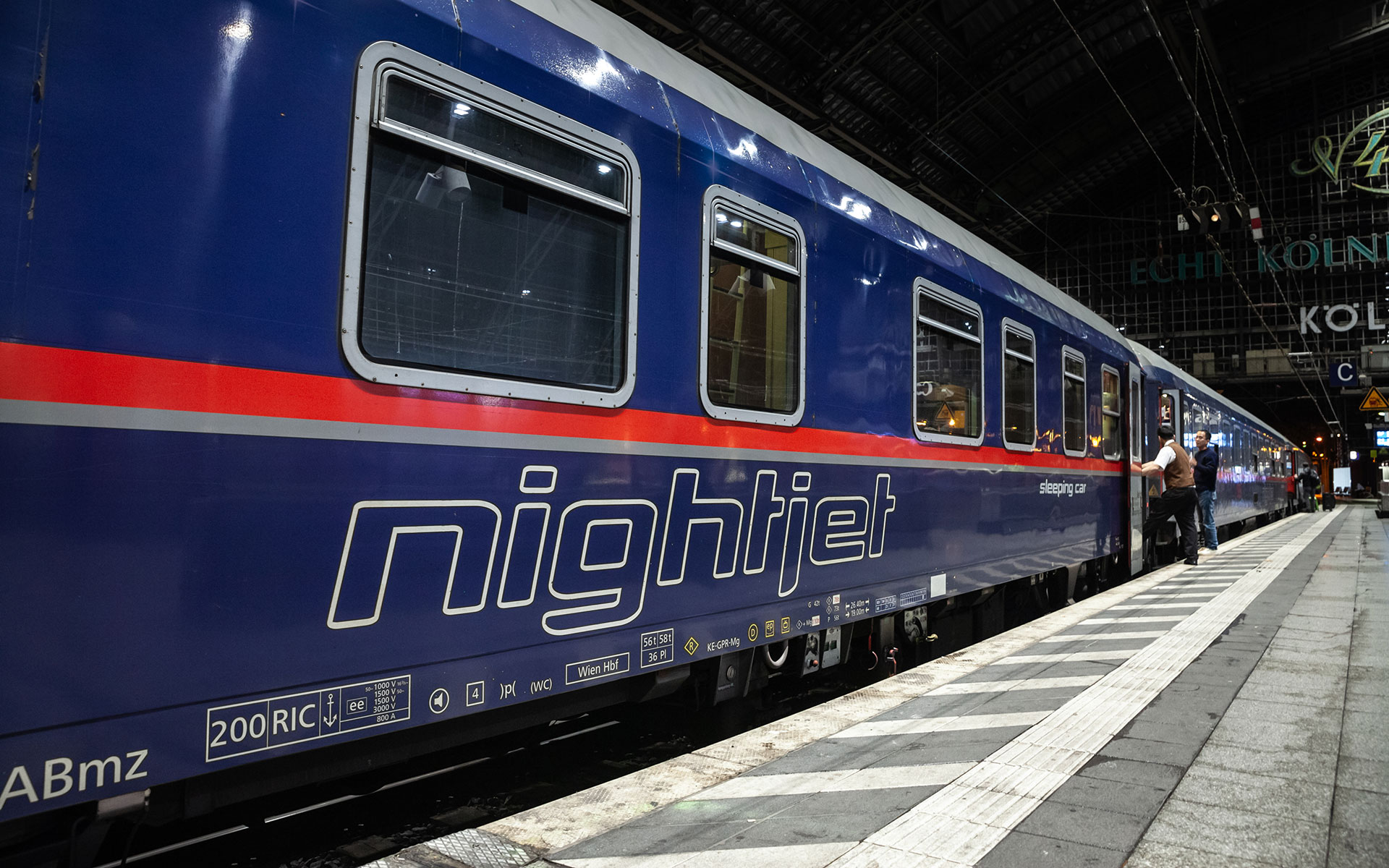25 years of European night trains
An ÖBB Nightjet en route to Vienna at Cologne station (photo © Jerome Cid / dreamstime.com).
The clamour for more and better night trains across Europe continues. Last month, a pyjama party held simultaneously at major stations in many European countries brought out activists keen to see many more night trains across the continent. Ideally trains full of creature comforts. And ideally at accessible prices which might encourage diehard flyers to switch from air to rail.
“Dream on,” you may say. Indeed, lots of European night trains were sadly axed in the ten years from 2005 through to 2015. But latterly there has been a welcome comeback with many new routes launched, among them Brussels to Prague, Berlin to Paris, Amsterdam to Zürich and Vienna to Genoa. On some routes, such as from Berlin to both Stockholm and Brussels, there is even now a choice of two competing night-train operators.
But we have also seen the fragility of Europe’s night train network. Poor timekeeping and legacy rolling stock prompt complaints. The Nightjet trains from Brussels and Paris to Berlin were suspended for some weeks this year after difficulty securing sensible timetable paths through Germany due to major infrastructure projects on the German network.
From mid-December 2024, all direct night trains from southern Germany to Italy are suspended for some months due to renovation work on the Tauern Railway through Austria. So the direct overnight train from Stuttgart to Venice won’t run. Nor will passengers be able to board sleeping cars in Munich for overnight journeys to Rome, Florence, Milan, Genoa or La Spezia.
Night trains in 1999
We chanced this week on a timetable for European night trains in 1999. So it’s interesting to look back and see what trains were running 25 years ago. Curiously, this volume was sponsored by the Union Internationale des Chemins des Fers (UIC); it’s a reminder of an era when UIC evidently was more public-facing, in this case producing a timetable which captured the collective offerings of 40 night train operators right across Europe.
So how did services look a quarter of a century ago? Remember that by 1999 many European high-speed lines were already up and running, so the overnight network had already been trimmed back from its peak in the 1970s and 1980s.
Belgian operator SNCB was still very much in the night train business with its own sleeping cars. Brussels to Milan ran nightly, continuing beyond Milan to Venice on certain days. There was a raft of seasonal services from Brussels to holiday destinations across France. There was a year-round Oostende to Vienna train, well timed to serve sea passengers arriving in Oostende from England.
Zürich was much better connected than it is nowadays, with the Pau Casals night train to Barcelona and the Gottardo to Rome, the latter carrying through couchette carriages to Venice. There was even a weekly seasonal overnight train from Zürich to Bari, Brindisi and Lecce.
The Balti Ekspress from Warsaw to Tallinn didn’t run in 1999, but there were other intriguing Baltic connections. On alternate nights there was a direct train with sleeping cars from Warsaw to Vilnius, following the classic route of the Tsarist-era railway from Warsaw, and passing through Grodno in the north-west corner of Belarus en route from Poland to Lithuania. The nightly St Petersburg to Warsaw train route also took this same route, clipping the corner of Belarus with a stop in Grodno. In addition to sleeping cars bound for the Polish capital, this train from Russia also carried sleepers for Gdynia.
The nightly Bulgaria Express from Sofia to Moscow also included through carriages to Minsk and St Petersburg. The overnight connection from Sofia to Chişinău in Moldova evidently didn’t run in 1999, but there was a direct seasonal overnight train from Varna on Bulgaria’s Black Sea coast to Chişinău. This service also carried sleeping cars from Constanţa to Chişinău.
The Serbian capital Belgrade has just one international night sleeper service these days. That’s the Lovćen which slips out of the Serbian capital at 20.30 each evening for an overnight run to Bar in Montenegro. Back in 1999, there was more nocturnal colour on Belgrade’s departure boards with direct night sleeper trains to Vienna, Thessaloniki, Moscow and Istanbul.
Can we tempt you with a few more delights from a quarter century ago? There was a direct overnight train from Berlin to Kaliningrad. And there were some remarkably short hops, with nightly departures from Paris to both Amsterdam and Frankfurt-am-Main. The latter two disappeared with the speeding up of daytime trains on those respective routes. And, would you believe, there was even a seasonal link from Germany to Spain with a direct service from Saarbrücken (in Germany’s Saar region) to Irun.
Sadly these overnight links are all long gone, but is there a chance that any of them could ever return? Time will tell, and meanwhile we’ll be keeping an eye on Europe’s 2025 train timetables to spot what new trains might be on offer in the months ahead.





About The Authors
Nicky Gardner and Susanne Kries
Nicky and Susanne manage hidden europe, a Berlin-based editorial bureau that supplies text and images to media across Europe. From 2005 to 2023, they were the editors of hidden europe magazine. Nicky and Susanne are dedicated slow travellers and the authors of the book Europe by Rail: The Definitive Guide. The 18th edition of that book was published in October 2024. You'll find a list of outlets that sell the book on this website. Susanne and Nicky also provide consultancy to the rail industry on fares, routes and ticketing. Between them, they know a thing or two about rail APIs.